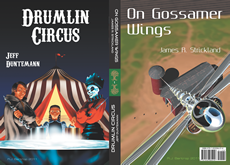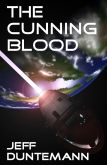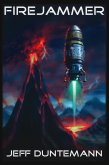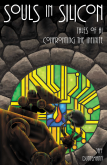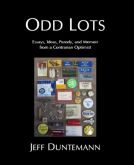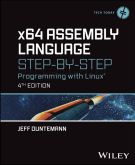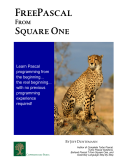Now that the Copperwood Double #1 (containing Drumlin Circus and On Gossamer Wings by Jim Strickland) has been out there for awhile, people have begun asking me again:
- You do know that a “drumlin” is a kind of hill, don’t you? (Yes.)
- Whythehell did you call your alien whatchacallits “drumlins”? (Read on.)
Language evolves to meet the needs of ordinary people. When a word doesn’t exist for a new concept, one will show up pretty quickly. Trade names will be genericized (xerox and kleenex are the best examples), wordsmiths will glue two or three things together, sometimes existing but obscure word will be repurposed, and occasionally something brand new will just appear out of nowhere.
SF writers are faced with this problem all the time. Back in the Sixties we assumed that three-dimensional television was just around the corner, and we struggled to come up with snappy terms for the idea. In my very early SF I used “triovision” and (later) “tridiac.” William Tenn’s “teledar” has always been one of my favorites. It has to be short and it has to trip easily off the tongue, or nobody will use it. Utterly invented words are hit and miss: I have long gotten flack for using the (invented) words “snerf,” “gront,” “blik,” and “frot” in stories involving witchery, as in “Whale Meat“; they are terms for difficult-to-describe mental powers that ordinary humans do not have. This was dangerous pre-Google: I innocently thought that I had invented the word “frot” in 1974 but, alas, I had not. (The witch-power later became “zot.”) Schmitz did a lot better with his “Sheewash Drive”, and never explained the origin of the term. Wholly fabricated words like that often sound silly, and work much better in whimsical or outright humorous tales. (Remember “lesnerize“?)
So there I sat in the summer of 2000, working out the details of a new story that I eventually called “Drumlin Boiler.” The concept had been cooking in the back of my head for some time: A starship full of human castaways on an unknown Earthlike planet discover alien machines scattered every few miles across the landscape. Today we might call the alien machines 3D printers or nanofabricators, because they make things: You tap in a 256-bit binary code to the machines’ two control surfaces, and an artifact bubbles up from a wide, shallow bowl filled with gray dust. What would people call the machines? I considered and threw out a number of outright fabrications, none of which I clearly recall. I tried a lot of derivatives, especially compressions of existing terms. “Cornies” was short for “cornucopias,” but it sounded more like breakfast cereal. Pass. Ditto “nanners,” for “nanofabricators.” “Tappers” had a lot more promise, and the alien machines were almost called tappers. I hesitated because the machines were not what was doing the tapping. Ultimately I went with “thingmakers,” because, well, that’s what they did.
I still needed a snappy name for the artifacts that came out of the thingmakers. My first candidate actually won, in a way: “thingies” are what rural people call the devices constructed by the thingmakers, particularly ones with no obvious use. It’s evocative, but it’s also inherently informal. I needed something better, something city people might use as readily as rural people. I had a long brainstorming list, which has perished, but included existing and invented terms like “dusters,” “drigs,” “drins,” and “yaags” (Yet Another Alien Gadget). The short list favorite was “tappit.” About then I got the notion that the two control surfaces would provide feedback with distinct sharp sounds. Adding sound to the images in my mind, what tapping out a code on the thingmaker pillars suggested more than anything else was banging on a set of bongo drums. Drummits? I liked that better. Drummings? Closer to purely descriptive–but somehow it suggested the slightly silly word “dumplings.” Then the word “drumlin” popped into my head. I’ll admit, I had heard the word before but didn’t know crisply what it was. I looked it up. I liked the word a lot. It spoke easily and suggested a thing that came about by drumming. The true definition seemed mighty obscure to me: A teardrop-shaped glacial hill. I figured not one person in fifty would know that.
So I repurposed it.
The word works very well in its new context, and the hills it truly refers to are rare enough so that I don’t think much confusion results. It can act as both a noun and an adjective. I think most people, especially those outside the hiking and skiing communities, probably assume that it’s a neologism.
The Naming of Invented Things is a serious challenge in SFF. I’ve written about it before. It’s about making the un-real not only sound real, but familiar–and it’s way tougher than it looks!
